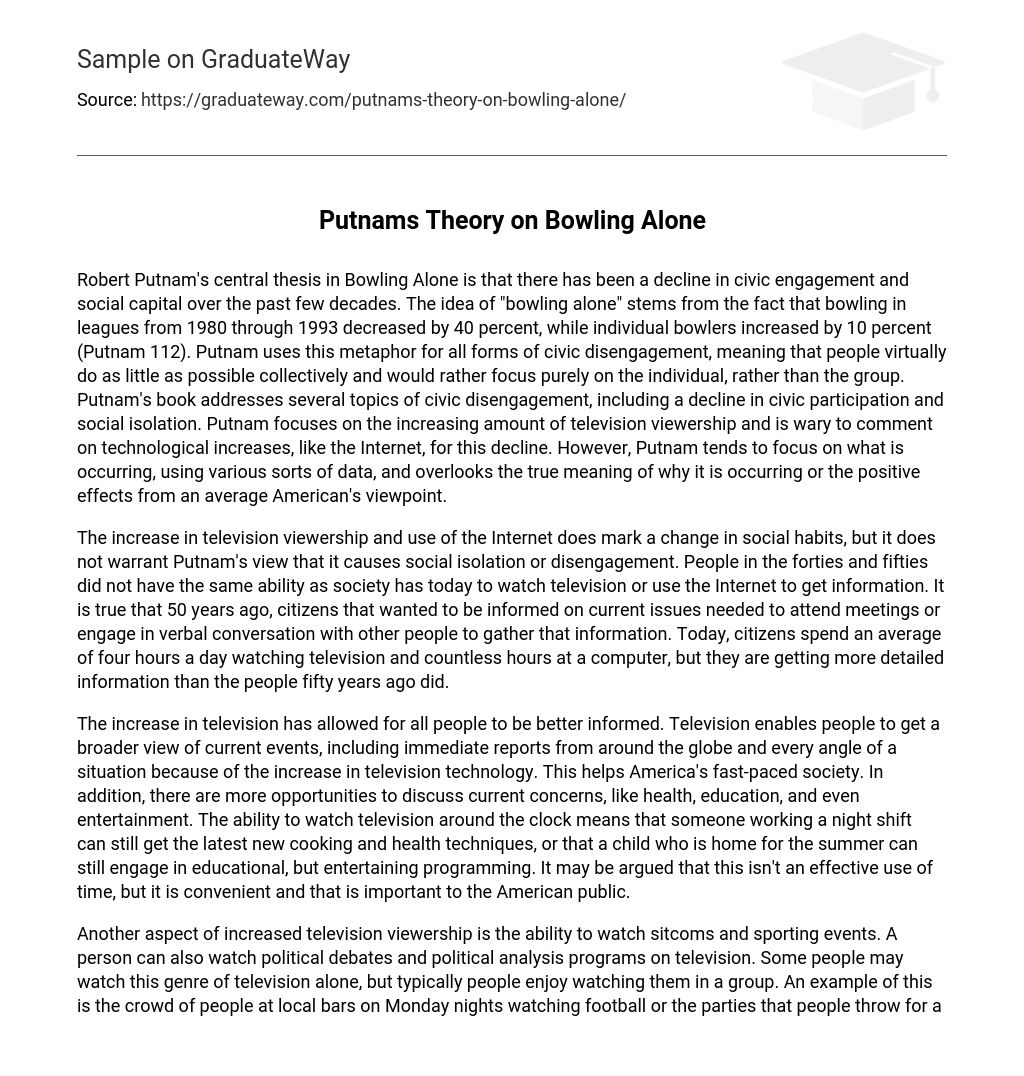In his book “Bowling Alone,” Robert Putnam discusses the decline of civic engagement and social capital in recent times. The phrase “bowling alone” symbolizes this decrease, with a 40 percent drop in participation in bowling leagues from 1980 to 1993, while individual bowlers increased by 10 percent (Putnam 112). This metaphor represents various forms of civic disengagement where individuals prioritize their own interests over collective action. Putnam’s book explores different aspects of civic disengagement, such as decreased civic participation and increased social isolation. While he acknowledges the increase in television viewership, Putnam does not explicitly address the impact of technological advancements like the Internet. Instead, he primarily focuses on describing the current situation using diverse data types, overlooking the underlying reasons for this decline or any potential benefits from an average American’s perspective.
Despite the increase in television viewership and internet usage, it is not valid to support Putnam’s assertion that it results in social isolation or disengagement. In previous decades, people did not have the same level of access to television or the internet for information gathering. At that time, staying informed about current issues required attending meetings or engaging in verbal conversations with others. Today, individuals spend an average of four hours daily watching TV and countless hours on computers. However, they actually receive more comprehensive information compared to those fifty years ago.
Television has become more prevalent, providing better information and a broader perspective on current events. The advancement of television technology allows for immediate global reports and comprehensive coverage from various angles, catering to America’s fast-paced society. Moreover, there are increased opportunities to discuss pressing matters such as health, education, and entertainment. With round-the-clock television access, even those working night shifts can stay updated on the latest cooking and health techniques. Likewise, children on summer break can engage in educational yet entertaining programming. While some may argue against its time effectiveness, the convenience it offers is crucial to the American public.
Increased television viewership not only includes sitcoms and sporting events but also political debates and analysis programs. While some individuals may watch this genre of television alone, it is more common for people to enjoy them in a group setting. For instance, Monday nights at local bars attract crowds of people watching football, and parties are thrown for season premieres or awards ceremonies. Additionally, families often gather during dinner to engage in debates on television. The rise in the number of restaurants over the past 30 years indicates a need for accommodating social interactions like these (Lemann 6). Despite claims that increased television watching leads to reduced civic participation and social involvement (Putnam 228), the prevalence of such group activities contradicts this notion.
According to Putnam (171), it is too early to determine the long-term social consequences of the Internet. Nonetheless, the favorable influence on society should be acknowledged. It should be noted that Putnam’s possession of a website (www.bowlingalone.com) suggests his belief in its value as a means of social participation and civic engagement.
Internet theorist Michael Strangelove defines the Internet as a platform that enables mass participation in fully bi-directional, uncensored mass communication. This expansive network has greatly enhanced communication between Americans and people worldwide.
The Internet has greatly affected the lives of those who can access it. It is commonly utilized for social and civic engagement through means like news groups, chat rooms, websites, and online boards. The Internet offers convenient access to a wealth of information, which is especially helpful for busy individuals in the United States. Information on the web is always accessible from any location. Some may argue that the Internet decreases face-to-face interaction, but there is no significant distinction between physically attending a meeting for an hour and conveniently listening to it online.
Putnam’s Book, Bowling Alone, provides a captivating examination of modern society. It puts forth persuasive points regarding the decrease in civic engagement and social involvement. However, Putnam appears to be unaware of the root cause behind this occurrence – the rapid pace of American life. Although this fact may be regrettable, it remains an inherent feature of our society.
Television and the Internet have provided Americans with the opportunity to actively engage in society and connect with their community, making them fortunate. These communication platforms are now crucial for fostering connections. However, there is an increasing pressure on Americans to achieve more and acquire greater knowledge. This can be seen through the long working hours and extensive time spent on phones or watching television. While Putnam may disapprove of these excessive activities, it can be argued that they have both economic and social benefits for Americans. Despite Putnam’s skepticism, embracing television and the Internet in American society might actually help individuals reach their goals, suggesting that “bowling alone” may not be entirely negative for Americans.
Works Cited
Lemann, Nicholas. “Kicking in Groups.” The Atlantic Monthly. April, 1996.
Putnam, Robert D. Bowling Alone. New York, NY. 2000.
Skocpol, Theda. “Unraveling from Above.” The American Prospect. March-April, 1996.
Valelly, Richard M. “Couch-Potato Democracy.” The American Prospect. March-April, 1996.
Websites:
www.bowlingalone.com (visited 9/30/00).





